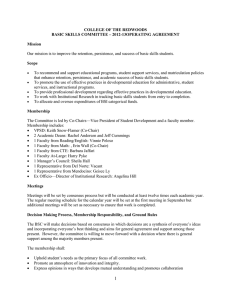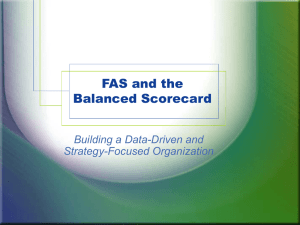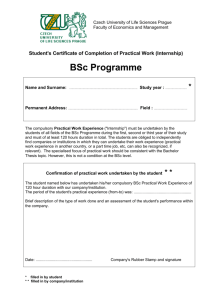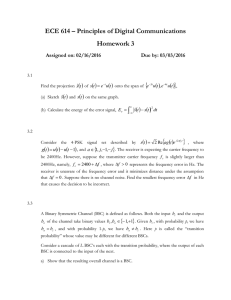Validating Cause-and-Effect Relationships in the Balanced Scorecard
advertisement
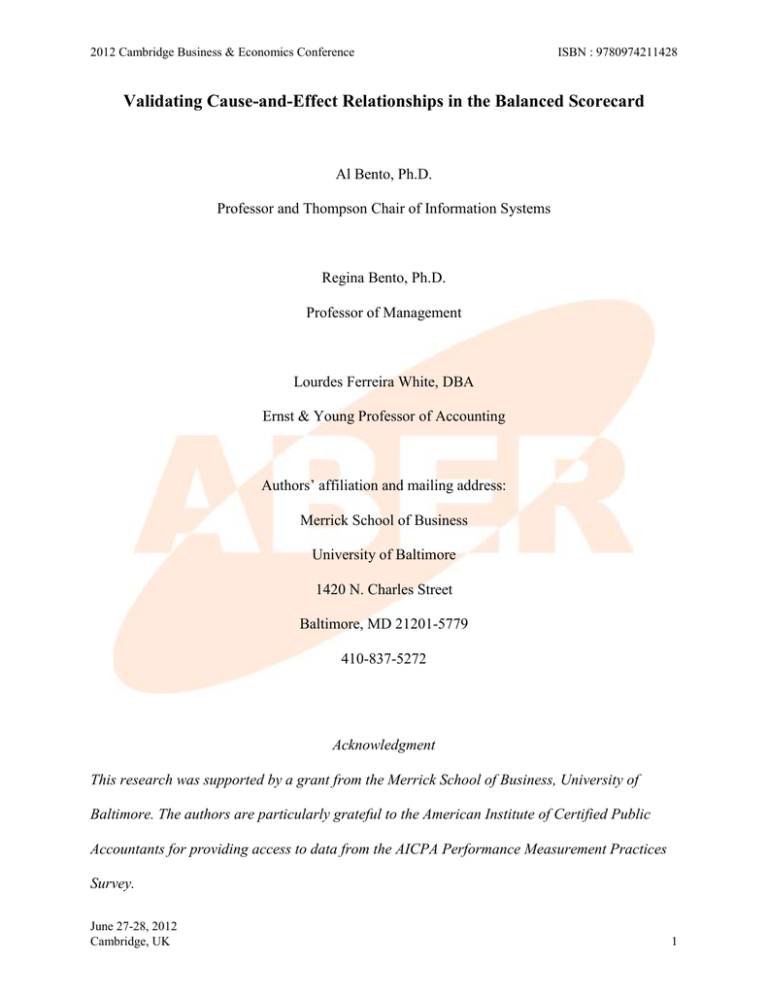
2012 Cambridge Business & Economics Conference ISBN : 9780974211428 Validating Cause-and-Effect Relationships in the Balanced Scorecard Al Bento, Ph.D. Professor and Thompson Chair of Information Systems Regina Bento, Ph.D. Professor of Management Lourdes Ferreira White, DBA Ernst & Young Professor of Accounting Authors’ affiliation and mailing address: Merrick School of Business University of Baltimore 1420 N. Charles Street Baltimore, MD 21201-5779 410-837-5272 Acknowledgment This research was supported by a grant from the Merrick School of Business, University of Baltimore. The authors are particularly grateful to the American Institute of Certified Public Accountants for providing access to data from the AICPA Performance Measurement Practices Survey. June 27-28, 2012 Cambridge, UK 1 2012 Cambridge Business & Economics Conference ISBN : 9780974211428 Validating Cause-and-Effect Relationships in the Balanced Scorecard ABSTRACT This paper proposes and tests a model to explain the cause-and-effect relationships among the four perspectives of the Balanced Scorecard: learning and growth, internal business processes, customer and financial. Drawing from the management, MIS and accounting literatures, the model proposes that the financial dimension is directly affected by continuous improvements in all of the other three perspectives. Using stepwise regression, we found preliminary empirical support for the model based on publicly available data for 332 companies included in the American Institute of Certified Public Accountants Performance Measurement Survey. Keywords Balanced Scorecard, Learning and Growth, Internal Business Processes, Customer and Financial performance measures. INTRODUCTION Performance management systems are often designed to enable organizations to plan, measure and control their performance, so that decisions, resources and activities can be better aligned with business strategies to achieve desired results and create shareholder value. For the past two decades, the Balanced Scorecard (BSC) has been proposed as an integrated framework for the implementation of financial and nonfinancial performance measures that helps organizations align their initiatives with the organization's strategy (Kaplan & Norton, 1992). By integrating lagging indicators of performance (outcome measures, such as financial results) with leading indicators (performance drivers, such as human resource skills) the BSC approaches June 27-28, 2012 Cambridge, UK 2 2012 Cambridge Business & Economics Conference ISBN : 9780974211428 performance from four different perspectives, and is intended to provide managers with a tool not simply for reporting but also for managing performance. These claims of enhanced strategic alignment and performance gains have motivated widespread adoption of the BSC in the private, public and nonprofit sectors; some studies have estimated rates of BSC adoption in the range of 60 to 70% among large organizations (Angel & Rampersad, 2005). In spite of the substantial investments devoted to the BSC, there is still insufficient empirical evidence on how effective these performance systems are in actually improving performance, and the processes by which the multiple perspectives of the BSC interact to produce tangible results. This study represents an effort to contribute to fill this practical and theoretical gap in four significant ways. First, it offers an overview of the extant research on the cause-and-effect relationships among the BSC perspectives. Second, it proposes a method for empirically testing how the BSC perspectives lead to performance outcomes, using publicly available, audited information (as opposed to perceptual data collected via surveys). Third, it illustrates one empirical test of the impact of the nonfinancial BSC perspectives on financial performance, based on a large sample of 332 publicly traded organizations in the United States (in contrast with previous small-sample studies). Fourth, it suggests that all of the nonfinancial BSC perspectives do, in fact, have a direct (as opposed to indirect) effect on financial results, addressing a long-standing debate in the BSC literature. The following sections present the overview of the literature, research question and hypotheses that were used to explore the financial impact of nonfinancial performance measures; the research methods that were employed to empirically test the model, the results obtained; and their implications for research and practice. June 27-28, 2012 Cambridge, UK 3 2012 Cambridge Business & Economics Conference ISBN : 9780974211428 LITERATURE REVIEW, RESEARCH QUESTION AND HYPOTHESES The Balanced Scorecard Framework The Balanced Scorecard was first proposed by Kaplan and Norton (1992) in their seminal article published in the Harvard Business Review. The BSC framework measures performance from four different perspectives: one financial and three nonfinancial. Financial measures of performance are relevant to senior managers as short-term feedback on the results of their past initiatives aimed at increasing shareholder value. In the BSC framework, these measures address the question: “If we succeed, how will we look to our shareholders?”. Nonfinancial measures are present in the other three perspectives of the BSC framework : the customer perspective (“to achieve my vision, how must I look to my customers?”); the internal perspective (“to satisfy my customers, at which processes must I excel?”); and the learning and growth perspective (“to achieve my vision, how must my organization learn and improve?”). The original BSC framework was further extended to provide a way of "translating strategy into a coherent set of performance measures” (Chenhall, 2005, p. 396). Kaplan and Norton (2004, p.11) proposed that managers "can view their strategic measures, not as performance indicators in four independent perspectives, but as a series of cause-and-effect linkages among objectives of the four balanced scorecard perspectives". They introduced the tool of the Strategy Map (Kaplan & Norton, 2004) to enable managers to see how performance in each perspective follows a hierarchical model whereby improvements in learning and growth (the lowest level in the hierarchy) lead to better internal processes (the second level) which, in turn, increase the value propositions delivered to customers (the third level), culminating in financial performance (the highest level). The goal is not to overload executives with dozens of performance metrics, which may divert managerial attention in opposite directions, but to offer a June 27-28, 2012 Cambridge, UK 4 2012 Cambridge Business & Economics Conference ISBN : 9780974211428 coherent set of actionable measures that tell the story of the organizational strategy. In their view, the strategic links among the BSC perspectives would allow managers to test the strategy using "if-then" propositions, so that continuous improvement in each of the nonfinancial perspectives would be monitored to assess if it translated ultimately into financial performance. For example, if an investment in information technology by an internet-based retailer (an achievement in the learning and growth perspective) could lead to faster and more accurate order fulfilment (a key business process in the internal perspective), then this could improve market share (a measure of increased customer value) leading to higher sales revenues (a financial indicator). If, on the other hand, such intangible investments did not result in improved financial performance, managers would receive a feedback loop informing them of the need to redraw the strategy map. Rather than a disastrous consequence, having the strategy map tested allows managers to undergo double loop learning through a re-evaluation of the strategy itself Overview of the Literature In a literature review of 136 studies published in the 2001-2011 period in the management, information systems and accounting literatures, assessing the relationships among the four BSC perspectives, we found only two empirically-based studies that specifically investigated the nature of the BSC relationships among the three nonfinancial and one financial perspectives. A notable contribution came from the work of Bryant, Jones, & Widener (2004) who tested whether each BSC perspective influenced performance in only the next perspective in the hierarchy (Kaplan & Norton, 1992) or whether outcome measures in the lower-level perspectives drove outcomes in all higher-level perspectives. Bryant, Jones and Widener referred to these two explanations as the "simple" and "complex" value-creation processes, respectively. Their results, based on proxies for seven generic outcome measures covering the June 27-28, 2012 Cambridge, UK 5 2012 Cambridge Business & Economics Conference ISBN : 9780974211428 four BSC perspectives, using a sample of 125 firms, suggest that the "complex" process best describes how each BSC perspective influences other perspectives. However, because of their methodological constraints, they were only able to find significant direct effects of market share (a customer perspective measure) on revenues (a financial measure). There were no significant direct effects of the learning and growth perspective on the financial perspective; a similar result was obtained for the internal perspective. They also concluded that whether or not the firm included nonfinancial measures in their managerial incentive compensation plans significantly altered the relationships among the BSC perspectives. More recently, a study based on survey data from 90 Greek companies identified a direct effect of the learning and growth perspective on the financial perspective, but the results were difficult to interpret, since the sample did not distinguish adopters from non-adopters of the BSC (Cohen, Thiraios, and Kandilorou, 2008). Consistent with traditional assumptions in the BSC literature, they found significant and positive relationships of the learning and growth perspective affecting the internal perspective, which, in turn, affects the customer perspective, consistent with the "simple model." Another study, focused on the hotel industry, also found supporting evidence for the "simple model" linking the customer and financial perspectives, but failed to identify links between learning and growth and financial results (Liang & Hou, 2006). On the other hand, the management literature provides some evidence that the learning and growth perspective may lead to financial results (Glaveli & Karassavidou, 2011); yet this stream of the management literature has typically ignored the explicit links between the two lower-level BSC perspectives (that is, how learning and growth affects the internal perspective). Extending the research on the "simple model" to three perspectives of the BSC, Chareonsuk & Chansa-ngavej (2010) identified June 27-28, 2012 Cambridge, UK 6 2012 Cambridge Business & Economics Conference ISBN : 9780974211428 that the learning and growth perspective influences the internal business perspective, leading to improved financial performance (skipping the customer perspective). However, the results were based on subjective opinion survey data, with a response rate of less than 10%. Apart from the above-mentioned studies, most research on the relationships among BSC perspectives has either focused on only one nonfinancial perspective of the BSC and its financial effects, or examined the relationships among isolated performance measures, disregarding the hierarchical structure of the four BSC perspectives. Examples of the first type of studies include early tests of the effects of customer satisfaction on financial performance in the hospitality (Banker, Potter, & Srinivasan, 2000) and telecommunications industries (Ittner & Larcker, 1998); a similar approach is applied in the financial services industry, linking the customer and financial perspectives using multiple measures from each perspective (Liang & Wang, 2008). Examples of the second type of studies, which test for relationships among sets of performance measures (J. Pastor Tejedor, Navarro Elola, & Pastor Tejedor, 2008) but disregard how they fit in with the hierarchy of the four BSC perspectives, have relied instead on statistical tools (Huang, Chu, & Wang, 2007) to discern the causal relationships among the strategic performance measures (Huang, 2008). The disregard for the overall hierarchical structure of the BSC in the academic literature reflects a similar lack of concern among practitioners. In a study of financial services firms, over 75% of the respondents reported no concern for the cause-and-effect relationships among the four BSC perspectives (Ittner, Larcker, & Randall, 2003). A recent study confirmed this neglect of causal relationships among BSC adopters in Italy, concluding that organizations that do not employ the strategy map feature of the BSC may not enjoy the full benefits from BSC implementation (Lucianetti, 2010). A related stream of literature has even argued that this June 27-28, 2012 Cambridge, UK 7 2012 Cambridge Business & Economics Conference ISBN : 9780974211428 disregard of the precise linkages between the nonfinancial and financial perspectives of performance may be desirable, because the excessive focus on the economic consequences of BSC adoption may lead organizations to miss out on the important political and strategic dimensions of performance measurement (Bessire & Baker, 2005). Research Question and Hypotheses In our study, we addressed this controversy in the BSC literature in terms of the following research question: Do investments in the learning and growth, internal, and customer perspectives have a direct effect on the financial perspective? The diagram in Figure 1 illustrates, in solid lines, the original relationships among the BSC perspectives proposed in the simple model, while the dotted lines suggest the complex model, whereby both the learning and growth and internal perspectives directly influence the financial outcomes. ====== Insert Figure 1 here ====== Based on the above discussion and on the model in Figure 1, we formulated the following hypotheses: Hypothesis 1: The learning and growth perspective has a direct, positive impact on the financial perspective. Hypothesis 2: The internal perspective has a direct, positive impact on the financial perspective. Hypothesis 3: The customer perspective has a direct, positive impact on the financial perspective. June 27-28, 2012 Cambridge, UK 8 2012 Cambridge Business & Economics Conference ISBN : 9780974211428 The learning and growth perspective In this perspective organizations measure their ability to provide the employee capability and skills (along with the technology and corporate climate) necessary to support organizational strategy (Kaplan & Norton, 2001, p. 94). As the skills and knowledge of employees increase, organizations are expected to make higher investments in compensation and retirement benefits to attract and retain employees. These investments are required to achieve the desired strategic skills coverage ratio, or the extent to which employees have the right strategic skill set to meet the organizational needs for a specific set of strategic jobs (Kaplan & Norton, 1996). In this study we use pension expenses to proxy for investments in the learning and growth perspective, as previously suggested in the BSC literature (Bryant et al., 2004) We expect that organizations that invest more in employee skills will also experience improved financial performance, because more competent employees will be better prepared and motivated to implement the organization's strategy successfully. The internal perspective The internal perspective encompasses the key business processes that organizations have to perform well in order to deliver customer value. A key process described in the BSC framework is innovation, which enables the organization to continuously develop new products and services to penetrate ever changing markets (Kaplan & Norton, 2001) In this perspective organizations measure their ability to sustain an ongoing research and development effort to provide products and services that meet customer expectations. In our study we use research and development expenses to proxy for investments in the internal perspective, consistent with prior BSC research (Bryant et al., 2004). While innovation is not the only key business process represented by the internal perspective, we expect that organizations with higher R&D June 27-28, 2012 Cambridge, UK 9 2012 Cambridge Business & Economics Conference ISBN : 9780974211428 investments will be more likely to reap the financial benefits of well designed products and services. The customer perspective The customer perspective measures the value propositions that the organizational strategy has identified for targeted customer groups. For example, one strategy may direct bank employees to emphasize excellent customer service to meet the needs of wealthier clients. An important outcome measure in the customer perspective is market share, as it signals to managers if the value propositions that the organization is currently delivering has secured a critical mass of customers. This measure has been often used in the BSC literature in relation to the customer perspective (Ittner, Larcker, & Rajan, 1997). Because customer acquisition is costly, we expect that organizations that already command higher market shares will also be more successful in the financial perspective. Market share also proxies for market leadership, which allows organizations to price their products competitively. Another common indicator of success in the customer perspective is customer satisfaction. However, this type of data is often fraught with measurement errors and onerous to obtain (Ittner & Larcker, 1998). Instead, in our study we use another proxy suggested by Kaplan and Norton (1996) as an indirect measure of customer satisfaction: accounts receivable. Customers who are happier with their products and services are more likely to pay on time and help their providers keep accounts receivable balances lower. Thus receivables provide an indirect measure of financial success. When customers are unhappy and withhold payments, organizations are under increased cashflow pressure to perform well financially. In our study we employed both market share and accounts receivable to proxy for measures in the customer perspective. We expect that organizations with higher market shares June 27-28, 2012 Cambridge, UK 10 2012 Cambridge Business & Economics Conference ISBN : 9780974211428 and lower accounts receivable balances are more likely to outperform others in the financial perspective. The financial perspective The financial perspective includes historical (lagging) measures that reflect the degree of success of the other BSC perspectives in achieving the organizational strategic objectives. Usually based on accounting information, the financial perspective is at the highest level in the hierarchy of BSC perspectives because decisions made under the other perspectives will ultimately culminate in (or fail to deliver) financial results. Kaplan and Norton proposed two main areas in which the financial perspective assesses results: revenue generation, and productivity. Because the emphasis on productivity may vary from one organization to another, depending on their relative strategic focus, in this study we focused on sales revenues as the measure to represent the financial perspective. This is consistent with prior studies (Bryant et al., 2004), where revenues proved to be a reliable indicator of the impact of other BSC perspectives. RESEARCH METHODS In this study we tested the model in Figure 1 using a subsample from the Performance Measurement Practices Survey conducted by the American Institute of Certified Public Accountants. In our prior study (Bento and White, 2010) we used this AICPA sample of 1,990 business professionals that included respondents from various functional areas such as accounting and finance, general management, operations, information technology and tax, representing organizations from every industry in the Dow Jones Global Industry Groups classification. Concerning the firms in the AICPA survey that reported using a form of the BSC, for this study we searched for publicly available information on the BSC perspectives for those firms, yielding a subsample of 332 firms. June 27-28, 2012 Cambridge, UK 11 2012 Cambridge Business & Economics Conference ISBN : 9780974211428 Four of the five variables in the model were measured with data obtained from COMPUSTAT: financial perspective: measured by sales customer perspective: measured by accounts receivable internal business perspective: measured by R&D learning and growth perspective: measured by pension and retirement-related expenses The other customer perspective variable, market share, was obtained from the Market Share Reporter estimates (published under the Business and Company Resource Center database). We performed stepwise regression analyses to investigate the relationships among the five variables described in Figure 1. This regression test allowed us to assess any direct effects of the learning and growth perspective and of the internal perspective on the financial perspective, while controlling for the effects of the other perspectives. It also helped us compare the relative strength of the relationships among the four BSC perspectives. RESULTS The main results for the regression analysis appear in Table 1. The four independent variables alone explain more than 45% of the cross-sectional variation in the financial perspective (adjusted R2=0.455, significant at the 0.0001 level). The significant relationships revealed by the data provide empirical support for the three hypotheses about our model: ====== Insert Table 1 here ====== June 27-28, 2012 Cambridge, UK 12 2012 Cambridge Business & Economics Conference ISBN : 9780974211428 Hypothesis 1 We found a significant, positive direct effect of the learning and growth perspective on the financial perspective, consistent with Hypothesis 1. Investments in pension and retirement benefits have a direct effect on the financial perspective, contrary to the common assumption in the BSC literature, which postulates that the learning and growth perspective affects only the internal business perspective. Relative to the other BSC perspectives, however, the learning and growth perspective had the weakest effect on the financial perspective. Hypothesis 2 There is a significant, positive and direct effect of the internal business perspective on the financial perspective, consistent with Hypothesis 2. Investments in R&D have a direct impact on the financial perspective, in contrast with the common assumption in the BSC literature, claiming that the internal and business perspective impacts only the customer perspective. In fact, this was the strongest relationship among the five variables in this study. Hypothesis 3 The customer perspective has a significant, positive direct effect on the financial perspective, consistent with both Hypothesis 3 and the common assumption in the BSC literature. We measured two dimensions of the customer perspective: customer satisfaction (proxied by accounts receivable) and customer retention (proxied by market share). The negative sign for the standardized coefficient related to accounts receivable is consistent with existing theory (Kaplan & Norton, 1996) because a higher accounts receivable balance is a potential indicator of low customer satisfaction, which is negatively related to performance in the financial perspective. On the other hand, the positive sign for the standardized coefficient related to market share reflects that organizations that are capable of retaining their customers and June 27-28, 2012 Cambridge, UK 13 2012 Cambridge Business & Economics Conference ISBN : 9780974211428 securing a large market share tend to outperform financially other organizations with lower customer retention rates and market shares. DISCUSSION AND CONCLUSIONS This study was intended to address the research question of whether the lower-level BSC perspectives of learning and growth and internal process have a direct impact on the higher-level financial perspective. Previous research on the BSC has typically treated the relationships among the four BSC perspectives from a hierarchical approach, where each lower perspective affects only the next perspective in the hierarchy, following the "simple" model. A few studies have examined the "complex" model which allows for direct effects of the lower BSC perspectives on the financial perspective. This study contributes empirical evidence to the complex model: investments in the learning and growth and internal perspectives have a measurable, direct impact on financial performance. Our results on the positive effect of the customer perspective on financial results are consistent with prior research. Our findings have wide implications for both researchers and practitioners. From a research viewpoint, building upon a previous study we conducted with the firms who participated in the AICPA Performance Measurement Survey (Bento and White, 2010), we were able to illustrate in this study that these significant relationships among BSC perspectives can be tested with publicly available data (circumventing the inherent limitations in perceptual data obtained via surveys), in large samples. This methodological approach may prove helpful for testing other features of the BSC, such as longitudinal tests of the time lag necessary for leading performance indicators to translate into lagging performance measures. By integrating results from the BSC literature in three disciplinary areas: MIS, accounting, and management, our study illustrates that the performance measurement literature June 27-28, 2012 Cambridge, UK 14 2012 Cambridge Business & Economics Conference ISBN : 9780974211428 stands to benefit from more interdisciplinary research. Future research could use theoretical propositions emerging from these different streams of literature to test alternative specifications of the model proposed in Figure 1, and thus extend existing theories of how performance systems can impact actual financial performance. For practitioners, our results suggest the importance of understanding the linkages among all four BSC perspectives, and of not delegating different parts of the BSC execution to separate subunits of the organization. The direct links to financial performance from all nonfinancial BSC perspectives serve as a reminder that managers at all levels are responsible for actions and outcomes that directly influence overall financial results. In particular, special attention must be placed on properly deploying and cultivating the intangible assets inherent in the learning and growth, internal and customer perspectives. REFERENCES Angel, R., & Rampersad, H. (2005). Do scorecards ADD UP? CA Magazine, 138(4), 30-35. Banker, R. D., Potter, G., & Srinivasan, D. (2000). An Empirical Investigation of an Incentive Plan that Includes Nonfinancial Performance Measures. Accounting Review, 75(1), 65. Bento, A. and White, L. (2010). ‘An exploratory study of strategic performance measurement systems’, Advances in Management Accounting, Vol.18, pp.1-26. Bessire, D., & Baker, C. R. (2005). The French Tableau de bord and the American Balanced Scorecard: a critical analysis. Critical Perspectives on Accounting, 16(6), 645-664. Bryant, L., Jones, D. A., & Widener, S. K. (2004). Managing Value Creation within the Firm: An Examination of Multiple Performance Measures. Journal of Management Accounting Research, 16, 107-131. June 27-28, 2012 Cambridge, UK 15 2012 Cambridge Business & Economics Conference ISBN : 9780974211428 Chareonsuk, C., & Chansa-ngavej, C. (2010). Intangible asset management framework: an empirical evidence. Industrial Management & Data Systems, 110(7), 1094-1112. Chenhall, R. H. (2005). Integrative strategic performance measurement systems, strategic alignment of manufacturing, learning and strategic outcomes: an exploratory study. Accounting, Organizations & Society, 30(5), 395-422. Cohen, S., Thiraios, D., & Kandilorou, M. (2008). Performance parameters interrelations from a balanced scorecard perspective: An analysis of Greek companies. Managerial Auditing Journal, 23(5), 485-503. Glaveli, N., & Karassavidou, E. (2011). Exploring a possible route through which training affects organizational performance: the case of a Greek bank. International Journal of Human Resource Management, 22(14), 2892-2923. Huang, H.-C., Chu, W., & Wang, W.-K. (2007). Strategic Performance Measurement and Value Drivers: Evidence from International Tourist Hotels in an Emerging Economy. Service Industries Journal, 27(8), 1111-1128. Huang, L. (2008). Strategic orientation and performance measurement model in Taiwan’s travel agencies. Service Industries Journal, 28(10), 1357-1383. Ittner, C. D., & Larcker, D. F. (1998). Are Nonfinancial Measures Leading Indicators of Financial Performance? An Analysis of Customer Satisfaction. Journal of Accounting Research, 36(3), 1-35. Ittner, C. D., Larcker, D. F., & Rajan, M. V. (1997). The choice of performance measures in annual bonus contracts. Accounting Review, 72(2), 231. June 27-28, 2012 Cambridge, UK 16 2012 Cambridge Business & Economics Conference ISBN : 9780974211428 Ittner, C. D., Larcker, D. F., & Randall, T. (2003). Performance implications of strategic performance measurement in financial services firms. Accounting, Organizations & Society, 28(7/8), 715. Kaplan, R. S., & Norton, D. P. (1992). The Balanced Scorecard--Measures That Drive Performance. Harvard Business Review, 70(1), 71-79. Kaplan, R. S., & Norton, D. P. (1996). The Balanced Scorecard: Translating Strategy into Action (1st ed.). Harvard Business Press. Kaplan, R. S., & Norton, D. P. (2001). Transforming the Balanced Scorecard from Performance Measurement to Strategic Management: Part I. Accounting Horizons, 15(1), 87-104. Kaplan, R. S., & Norton, D. P. (2004). The strategy map: guide to aligning intangible assets. Strategy & Leadership, 32(5), 10-17. Liang, C.-J., & Hou, L.-C. (2006). A Dynamic Connection of Balanced Scorecard Applied for the Hotel. Journal of Services Research, 6(2), 91-118. Liang, C.-J., & Wang, W.-H. (2008). How managers in the financial services industry ensure financial performance. Service Industries Journal, 28(2), 193-210. Lucianetti, L. (2010). The impact of the strategy maps on balanced scorecard performance. International Journal of Business Performance Management, 12(1), 3. Pastor Tejedor, J., Navarro Elola, L., & Pastor Tejedor, A. C. (2008). The application of neural networks in the study of the influence of temporality on strategy map indicators in a Spanish hospital. Total Quality Management & Business Excellence, 19(6), 643-659. June 27-28, 2012 Cambridge, UK 17 2012 Cambridge Business & Economics Conference ISBN : 9780974211428 Figure 1: Cause-and-effect relationships among Balanced Scorecard Perspectives Table 1: Regression results for the impact on the financial perspective Dependent variable Independent variables Beta Market Share Accounts Receivable Internal Perspective Learning and Growth Perspective .297 -.222 .490 .174 Financial Perspective June 27-28, 2012 Cambridge, UK R̿ 2 .455 Significance .0001 18

